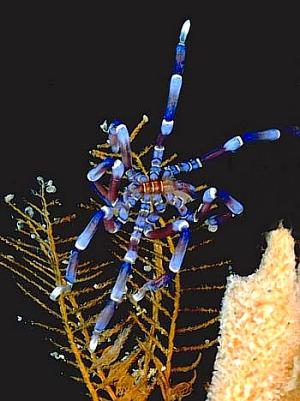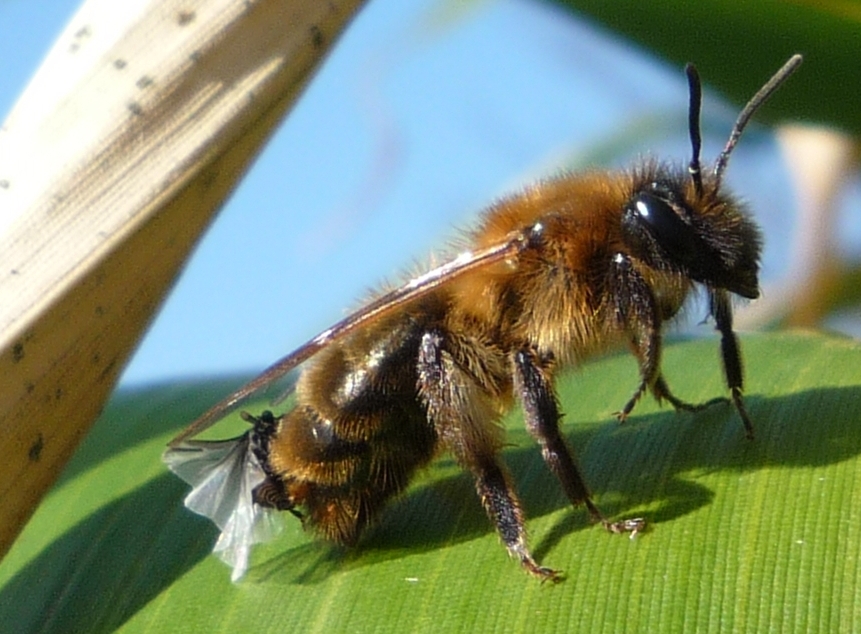Anyway, the wonderful thing about paleontology is that the extinct things one encounters through it are not always directly analogous to modern life forms. Dinosaurs, trilobites and ammonites–the Holy Trinity of paleontology–are all certainly not alien, but they aren't just humdrum prehistoric blueprints of their current ecological counterparts, being rather something distinctive and apart.
Fossilized insects, unfortunately, do not often diverge dramatically from modern ones: it seems that once a body-plan evolves among them it is never lost, and if its exponents die out utterly it will likely be recapitulated later on by an unrelated lineage. The notorious griffinflies (order Meganisoptera) that patrolled Earth's skies for 67 million years, including the 28-in.wingspan Meganeuropsis, were essentially hawk-sized dragonflies (a taxonomic oversimplification but an ecological truth); the various members of the superorder Dictyoptera (cockroaches, mantids and termites), both living and dead, are more or less Variations on the Theme of "I Am a Roach"–e.g., We Are Roaches With Sclerotized Forewings (Umenocoleidae), We Are Carnivorous Mantis-Like Roaches (Raphidiomimidae), I Am a Roach With Earwig-esque Cerci With Which I Probably Clasped My Mate (Fuziidae), and I Am a Roach With Leaping Hind Legs and a Name Like That of a Romulan (Skok).
Thankfully, there are exceptions. The Kalligrammatidae were fluttering, colorful pollinators often termed "the butterflies of the Mesozoic"...but they were close kin of antlions (which they hardly resembled), and are only distant cousins of their extant namesakes. (See "Butterflies Before Butterflies, Flowers Before Flowers".) And, of course, there were the Chresmodidae, which are what I am posting about, although it may be hard to tell that from what I have written so far.
Chresmodids were spindly insects with slender, elongated legs. Females were winged; males, wingless. Their wing morphology (and venation), cerci, and ovipositor unanimously point to an affinity with the Polyneoptera, a varied assemblage of such organisms as grasshoppers, earwigs, and praying mantises (although chresmodids were classified elsewhere as recently as 1980). The fact that chresmodid nymphs are known (indicating that, like polyneopterans, they exhibited incomplete metamorphosis) seals the matter (Delclòs et al., 2008). But beyond that their relationships are debatable–this being but one of their interesting aspects.
 |
| Crummy picture of a crummy fossil of Chresmoda obscura |
 |
| In flagrante delicto Quebecoi Aquarius remigis (Gerridae); caught in the act by Philippe Moniotte |
No, it appears that Chresmoda sp. owe their gigantism to a unique aspect of their tarsi: namely, the fact that said tarsi were unreservedly flagellate, the 2 foremost tarsomeres (the segments which comprise an insect's foot) being subdivided into an excess of 40 tiny articles in what was apparently a means of spreading weight (Martínez-Delclòs, 1991). Why does this warrant italicization? Well, the foundational morphology from which all insects descend has no more than 5 podites: numerous lineages among the Insecta have less than that, but never more, with the strange exception of Chresmoda.
 |
| A Carcharodontosaurus saharicus skull compared to that of a Homo sapiens by Louie Psihoyos |
 |
| The gates of Hades swing wide and from the abyss comes Damon diadema! |
 |
| Sea spider (Phoxichilidiidae: Anoplodactylus evansi) photographed by Bill Rudman near New South Wales |
 |
| Water measurer (Hydrometra martini, Hydrometridae) photographed by Tom Murray |
 |
| Timema sp. (Timematidae) pornography created by Scott Peden |
Additionally, the identity of the prehistoric taxa to which the Chresmodidae are obviously related (yes! There are some!) has been debated over the years. These mostly Mesozoic fossils–of which the Cretaceous-Paleogene Susumaniidae (Gorochov, 1988), the Jurassic Necrophasma (Martynov, 1928), and the Triassic Aeroplanidae (Tillyard, 1918) are some examples–have been often classified as Phasmatodea (Gorochov, 1994), but for the most part they consist only of wings, meaning that their identity as stick insects is based entirely upon venation. Well and good, except that their putative living kin's wings are reduced and heavily sclerotized, if not absent outright, making modern stick insect wing venation difficult and/or impossible to study (Wedmann et al., 2007). Furthermore, since the body is usually lacking in these fossils, in them one cannot confirm the presence of a vomer (a portion of male stick insects' naughty bits): a telltale apomorphy of modern phasmatodeans. (Significantly, chresmodid males lacked a vomer.) Hence, these purported basal stick insects' identification has been doubted (Tilgner, 2001). However, the twin discoveries of Gallophasma–a clichéd "missing link" between the alleged pre-Neogene Phasmatodea and their present-day ilk (Nel et al., 2010)–and a susumaniid with a vomer (Nel & Defosse, 2011) would seem to confirm that chresmodids are, indeed, stick insects (although controversy remains; Bradler and Buckley, 2011).
If so, then I must say that they are weird stick insects.
_____________________________________________________________
Andersen, N. M. (1982). The Semiaquatic Bugs (Hemiptera: Gerromorpha): Phylogeny, Adaptations, Biogeography and Classification. Klampenborg: Scandinavian Science Press.
Beutel, R. G. and Gorb, S. N. (2006). A revised interpretation of the evolution of attachment structures in Hexapoda (Arthropoda), with special emphasis on Mantophasmatodea. Arhropod Systematics and Phylogeny, 64(1), 3-25.
Bradler, S. and Buckley, T. R. (2011). Stick insect on unsafe ground: does a fossil from the early Eocene of France really link Mesozoic taxa with the extant crown group of Phasmatodea [electronic version]? Systematic Entomology, 36(2), 218-222. Retrieved 2/28/13 from http://onlinelibrary.wiley.com/doi/10.1111/j.1365-3113.2010.00564.x/pdf
Brusatte, S.L. and Sereno, P.C. (2007). A new species of Carcharodontosaurus (dinosauria: theropoda) from the Cenomanian of Niger and a revision of the genus. Journal of Vertebrate Paleontology, 27(4).
Carpenter, F. M. (1992). Superclass Hexapoda. In Moore, R. C. and Kaesler, R. L. (eds.): Treatise on Invertebrate Paleontology, R, Arthropoda pt. 4. Boulder & Lawrence: Geological Society of America & University of Kansas Press.
Delclòs, X.; Nel, A.; Azar, D.; Bechly, G.; Dunlop, J. A.; Engel, M. S.; and Heads, S. W. (2008). The Enigmatic Mesozoic Insect Taxon Chresmodidae (Polyneoptera): New Paleobiological and Phylogenetic Data, with the Description of a New Species from the Lower Cretaceous of Brazil. N. Jb. Palaeont. Abh., 247(3), 353-381. Retrieved 2/26/13 from http://www.bernstein.naturkundemuseum-bw.de/odonata/Chresmodidae.pdf
Frickhinger, K. A. (1999). Die Fossilien von Solnhofen (vol. 2). Korb: Goldschneck.
Germar, E. F. (1839). Die versteinerten Insekten Solnhofens. Nova Acta Leopoldina Carolina Akademia, 19(1), 187-222.
Gorochov, A. V. (1988). On the classification of fossil orthopterans of the superfamily Phasmomimoidea (Orthoptera) with a description of new taxa [in Russian]. Trudy Zoologicheskogo Instituta Akademii nauk SSSR, St. Petersburg; 178, 32-44.
Gorochov, A. V. (1994). Permian and Triassic walking sticks (Phasmatodea) from Eurasia. Paleontological Journal, 28(4), 83-97.
Haase, E. (1890). Beiträge zur Kenntnis der fossilen Arachniden. Zeitschriften der Deutschen Geologischen Gesellschaft, 42, 629-657.
Handlirsch, A. (1906). Ein Handbuch für Paläontologen und Zoologen. Leipzig: Engelmann.
Kjer, K. M.; Carle, F. L.; Litman, J.; and Ware, J. (2006). A molecular phylogeny of Insecta. Arthropod Systematics & Phylogeny, 64(1), 35-44.
Kuhn, O. (1977). Die Tierwelt des Solnhofener Schiefers (5th edition). Wittenberg: Ziemsen.
Martínez-Delclòs, X. (1991). Insects hemimetàbols del Cretaci inferior del España. Tafonomia i Paleoautoecologia. University of Barcelona: doctoral thesis.
Martynov, A. V. (1928). A new fossil form of Phasmatodea from Galkino (Turkestan), and on Mesozoic phasmids in general. Annals and Magazine of Natural History, 10, 319-328.
Nel, A.; Azar, D.; Martínez-Delclòs, X.; and Makhoul, E. (2004). A new Upper Cretaceous species of Chresmoda from Lebanon–a latest representative of Chresmodidae (Insecta: Polyneoptera inc. sed.): first record of homeotic mutations in the fossil record of insects. European Journal of Entomology, 101(1), 145-151.
Nel, A.; Delfosse, E.; Robillard, T.; and Petrulevičius, J. F. (2010). An early winged crown group stick insect from the Early Eocene amber of France (Insecta, Phasmatodea). Systematic Entomology, 35, 340-346.
Nel, A. and Delfosse, E. (2011). A new Chinese Mesozoic stick insect [electronic version]. Acta Palaeontologica Polonica, 56(2), 429-432. Retrieved 2/28/12 from http://www.app.pan.pl/archive/published/app56/app20091108.pdf
Oppenheim, P. (1888). Die Insectenwelt des lithographischen Schiefers in Bayern. Palaeontographica, 34, 215-247.
Petrunkevitch, A. I. (1955). Arachnida. In Moore, R. C. (ed.): Treatise on Invertebrate Palaeontology, Part P, Arthropoda Pt. 2 (vol. 2) (pp. 42-162). Lawrence: Geological Society of America & University of Kansas Press.
Ponomarenko, A. G. (1985). Fossil insects from the Tithonian "Solnhofener Plattenkalke" in the Museum of Natural History, Vienna. Annalen des Naturhistorischen Museums in Wien, 87A, 135-144.
Popov, Y. A. (1980). Superorder Cimicidea Laicharting, 1781. Order Cimicina Laicharting 1781. In Rohdendorf, B. B. and Rasnitsyn, A. P. (eds.): Historical development of the class of insects. Trudy Paleontologicheskogo Instituta, Akademiya Nauk S.S.S.R., Moskva; 175, 58-69.
Rasnitsyn, A. P. and Quicke, D. L. J. (2002). History of Insects. Dordrecht: Kluwer.
Rowland, J. M. and Sissom, W. D. (1980). Report on a fossil palpigrade from the Tertiary of Arizona, and a review of the morphology and systematics of the order. Journal of Arachnology, 8, 69-86.
Sharov, A. G. (1968). Filogeniya ortopteroidnykh nasekomykh. Trudy Paleontologicheskogo Instituta, Akademiya Nauk S.S.S.R., Moskva; 118, 1-216.
Tilgner, E. (2001). The fossil record of Phasmida (Insecta: Neoptera). Insect Systematics and Evolution, 31(4), 473-480.
Tillyard, R. J. (1918). Mesozoic Insects from Queensland. 3. Odonata and Protodonata. Proceedings of the Linnean Society of New South Wales, 43, 417-435.
Wedmann, S.; Bradler, S.; and Rust, J. (2007). The first fossil leaf insect: 47 million years of specialized cryptic morphology and behavior. Proceedings of the National Academy of Sciences of the USA, 104(2), 565-569.
Westwood, J. O. (1854). Contributions to Fossil Entomology. The Quarterly Journal of the Geological Society of London, 10, 378-396.
Weyenbergh, H. (1874). Varia zoological et paleontologica. Periodico Zoologico, Sociedad Entomologica Argentina; 1, 77-111.








